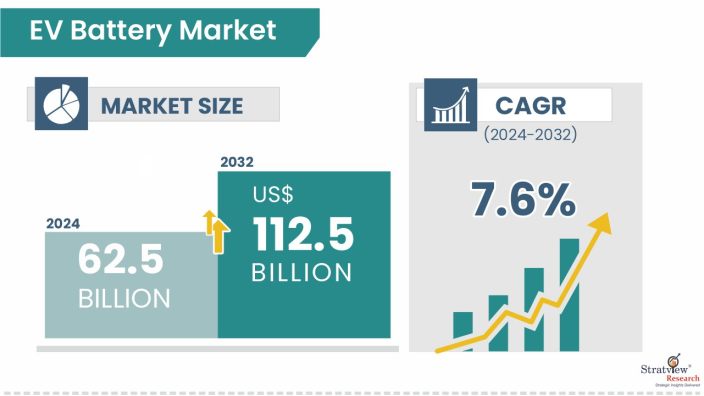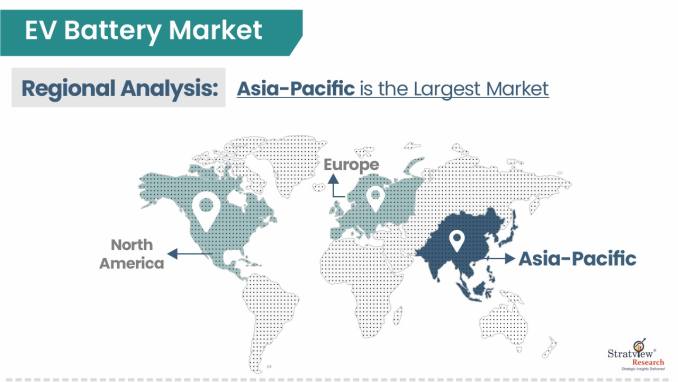Market Insights
The EV battery market value was USD 62.5 billion in 2024 and is likely to grow at an impressive CAGR of 7.6% during 2024-2032 to reach USD 112.5 billion in 2032.

Want to know more about the market scope? Register Here
Market Dynamics
Introduction
The EV battery market is on track for significant growth, driven by the rising popularity of electric vehicles, advancements in battery technology, and strong government support. As concerns over climate change intensify, more consumers and businesses are shifting towards sustainable transportation, fueling demand for EVs. In response, companies are ramping up battery production and forging strategic partnerships to enhance efficiency and sustainability. For example, General Motors’ collaboration with Vianode aims to improve battery performance by using high-quality anode graphite with a lower environmental impact. Additionally, government initiatives, such as the U.S. Department of Energy’s planned $3 billion investment in domestic battery production, are further accelerating industry growth. Continuous improvements in battery chemistry and the push for longer-range, faster-charging EVs are also creating new opportunities in the market. The transition towards electric commercial vehicles is another key driver, increasing the demand for high-capacity batteries to support the growing fleet of electric trucks and buses.
A critical component in this evolution is the negative electrode (anode), which plays a key role in battery performance and efficiency. As the demand for higher-capacity and longer-lasting EV batteries grows, advancements in anode materials are becoming increasingly important. The anode is responsible for storing and releasing lithium ions, directly influencing a battery’s energy density, lifespan, and charging speed. New materials, such as silicon-carbon composites and nanocomposite alloys, are significantly improving battery durability and overall efficiency.
Recent developments highlight this shift. General Motors’ decision to source anode graphite from Vianode reflects a broader industry move towards sustainable, high-performance materials that enhance battery life while reducing environmental impact. Automakers and battery manufacturers are focused on boosting energy density, extending battery longevity, and improving safety, making anode technology a central part of the next-generation EV battery landscape. As innovation continues, advanced anode materials will play a crucial role in shaping the future of electric vehicles.
Market Segments' Analysis
|
Segmentations
|
List of Sub-Segments
|
Segments with High Growth Opportunity
|
|
Battery-Type Analysis
|
Lithium-ion, Lead Acid, Nickel Metal Hydride, Others
|
Lithium-ion batteries are expected to be the demand generator for battery type in the EV Battery market, whereas Lead-acid batteries are likely to grow at the fastest rate in the coming years.
|
|
Vehicle-Type Analysis
|
BEVs, PHEVs, HEVs
|
BEVs are expected to contribute the largest share of the EV Battery market.
|
|
Region Analysis
|
North America, Europe, Asia Pacific, Rest of the World
|
Asia Pacific is expected to maintain its reign over the forecast period.
|
By Battery Type
“Lithium-ion batteries are projected to drive demand in the EV Battery market, while lead-acid batteries are expected to experience the fastest growth in the coming years.”
Lithium-ion batteries dominate the EV market due to their lightweight design and high energy density, powering most electric and hybrid vehicles, with ongoing research enhancing their efficiency. Lead-acid batteries, mainly used as auxiliary power units, are seeing demand growth, though advancements in lithium-ion alternatives may impact their future. Nickel-metal hydride (NiMH) batteries remain a key choice for hybrid vehicles, particularly in emerging markets. Meanwhile, sodium-ion batteries, a low-cost alternative to lithium-ion, are expected to enter mass production after 2025, potentially influencing future market dynamics.
By Vehicle Type
“BEVs are expected to hold the largest share of the EV Battery market during the forecast period.”
BEVs are expected to dominate the EV Battery market due to their zero emissions, lower operating costs, and strong government support worldwide. Stricter emission regulations and shifting away from internal combustion engines are driving their adoption. Advancements in battery technology, expanding charging infrastructure, and declining battery costs are making BEVs more accessible. Their higher battery capacity than hybrids further boost battery demand, solidifying their market leadership.
Regional Insights
“The Asia Pacific region is anticipated to retain its dominance throughout the forecast period.”
Asia Pacific is set to remain a leader in the EV Battery market, driven by its well-established manufacturing industry, government initiatives, and rising demand for electric vehicles. Countries like China, Japan, and South Korea are home to major battery manufacturers, ensuring steady production and innovation. Supportive policies and incentives have further encouraged growth, while access to key raw materials like lithium and cobalt strengthens the region’s supply chain. With ongoing advancements in battery technology and increasing EV adoption, Asia Pacific is well-positioned to stay at the forefront of this market in the coming years.

Know the high-growth countries in this report. Register Here
Key Players
The following are the key players in the EV battery market. Some of the major players provide a complete range of services.
Here is the list of the Top Players (Alphabetically)
- CATL (Contemporary Amperex Technology Co., Limited)
- BYD Company Ltd.
- LG Energy Solution Ltd.
- Panasonic Corporation
- SK Innovation Co., Ltd.
- Samsung SDI Co., Ltd.
- Gotion High-Tech
- AESC (Automotive Energy Supply Corporation)
- EVE Energy Co., Ltd.
- Farasis Energy
- Toshiba Corporation
Note: The above list does not necessarily include all the top players in the market.
Are you the leading player in this market? We would love to include your name. Please write to us at sales@stratviewresearch.com
Report Features
This report provides market intelligence most comprehensively. The report structure has been kept so that it offers maximum business value. It provides critical insights into market dynamics and will enable strategic decision-making for existing market players as well as those willing to enter the market. The following are the key features of the report:
- Market structure: Overview, industry life cycle analysis, supply chain analysis.
- Market environment analysis: Growth drivers and constraints, Porter’s five forces analysis, SWOT analysis.
- Market trend and forecast analysis.
- Market segment trend and forecast.
- Competitive landscape and dynamics: Market share, Service portfolio, New Product Launches, etc.
- COVID-19 impact and its recovery curve
- Attractive market segments and associated growth opportunities.
- Emerging trends.
- Strategic growth opportunities for the existing and new players.
- Key success factors.
Market Segmentation
This report studies the market, covering a period of 12 years of trends and forecasts. The report provides detailed insights into the market dynamics to enable informed business decision-making and growth strategy formulation based on the opportunities present in the market.
The global EV Battery market is segmented into the following categories.
By Battery Type
- Lithium-ion (Regional Analysis: North America, Europe, Asia-Pacific, and RoW)
- Lead Acid (Regional Analysis: North America, Europe, Asia-Pacific, and RoW)
- Nickel Metal Hydride (Regional Analysis: North America, Europe, Asia-Pacific, and RoW)
- Others (Regional Analysis: North America, Europe, Asia-Pacific, and RoW)
By Vehicle Type
- BEVs (Regional Analysis: North America, Europe, Asia-Pacific, and RoW)
- HEVs (Regional Analysis: North America, Europe, Asia-Pacific, and RoW)
- PHEVs (Regional Analysis: North America, Europe, Asia-Pacific, and RoW)
By Region
- North America (Country Analysis: The USA, Canada, and Mexico)
- Europe (Country Analysis: Germany, France, The UK, Russia, and Rest of Europe)
- Asia-Pacific (Country Analysis: Japan, China, India, and Rest of Asia-Pacific)
- Rest of the World (Country Analysis: Brazil, Saudi Arabia, and Others)
Research Methodology
- This strategic assessment report from Stratview Research provides a comprehensive analysis that reflects today’s EV battery market realities and future market possibilities for the forecast period.
- The report segments and analyzes the market in the most detailed manner to provide a panoramic view of the market.
- The vital data/information provided in the report can play a crucial role for market participants and investors in identifying the low-hanging fruits available in the market and formulating growth strategies to expedite their growth process.
- This report offers high-quality insights and is the outcome of a detailed research methodology comprising extensive secondary research, rigorous primary interviews with industry stakeholders, and validation and triangulation with Stratview Research’s internal database and statistical tools.
- More than 1,000 authenticated secondary sources, such as company annual reports, fact books, press releases, journals, investor presentations, white papers, patents, and articles, have been leveraged to gather the data.
- We conducted more than 15 detailed primary interviews with market players across the value chain in all four regions and industry experts to obtain both qualitative and quantitative insights.
Report Customization Options
With this detailed report, Stratview Research offers one of the following free customization options to our respectable clients:
Company Profiling
- Detailed profiling of additional market players (up to three players)
- SWOT analysis of key players (up to three players)
Competitive Benchmarking
- Benchmarking of key players on the following parameters: Service portfolio, geographical reach, regional presence, and strategic alliances
Custom Research: Stratview Research offers custom research services across sectors. In case of any custom research requirement related to market assessment, competitive benchmarking, sourcing and procurement, target screening, and others, please send your inquiry to sales@stratviewresearch.com

